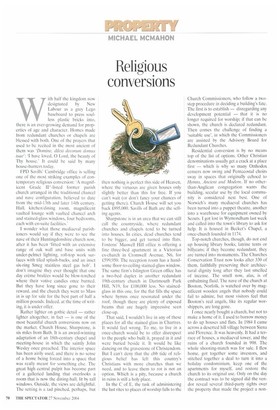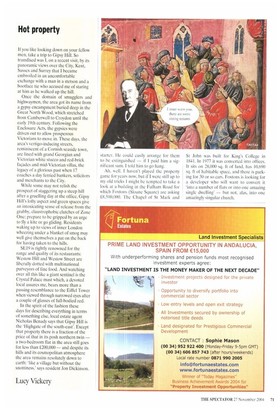Religious conversions
MICHAEL MCMAHUN
Nvith half the kingdom now designated by New Labour as a grey Lego baseboard to press soulless plastic bricks into, there is an ever-growing demand for properties of age and character. Homes made from redundant churches or chapels are blessed with both. One of the prayers that used to be recited in the most ancient of them was Domine, ddexi decorum damns tune': 'I have loved, 0 Lord, the beauty of Thy house.' It could be said by many house-hunters today.
HD Savills' Cambridge office is selling one of the most striking examples of contemporary religious conversion: 'A magnificent Grade II*-listed former parish church arranged in the traditional chancel and nave configuration, believed to date from the mid-13th and later 14th century. Hall, kitchen/dining room, magnificent vaulted lounge with vaulted chancel arch and stained-glass windows, four bedrooms, each with en-suite facilities.'
I wonder what those mediaeval parishioners would say if they were to see the nave of their Huntingdonshire church now, after it has been 'fitted with an extensive range of oak wall and base units with under-pelmet lighting, roll-top work surfaces with tiled splash-backs, and an inset six-ring Smeg stainless steel gas hob'. I don't imagine they ever thought that one day creme brulees would be blow-torched where their votive candles once burned. But they have long since gone to their reward, and the church they went to Mass in is up for sale for the best part of half a million pounds. Indeed, at the time of writing, it is under offer.
Rather lighter on gothic detail — rather lighter altogether, in fact — is one of the most beautiful church conversions now on the market. Church House, Sharpstone, is six miles from Bath. It is an award-winning adaptation of an 18th-century chapel and meeting-house in which the saintly John Wesley once preached. The interior space has been airily used, and there is no sense of a home being forced into a space that was really meant for something else. The great high central pulpit has become part of a galleried landing that overlooks a room that is now the dining-hall, lit by tall windows. Outside, the views are delightful. The setting is a tad pinched, perhaps, but then nothing is perfect this side of Heaven, where the virtuous are given houses only slightly better than this for free, If you Can't wait (or don't fancy your chances of getting there). Church House will set you back £895,000. Savills of Bath arc the selling agents.
Sharpstone is in an area that we can still call the countryside, where redundant churches and chapels tend to be turned into houses. In cities, dead churches tend to be bigger, and get turned into flats. Foxtons' Muswell Hill office is offering a fine three-bed apartment in a Victorian ex-church in Cromwell Avenue, N6, for £599,950. The reception room has a handsome floor-to-ceiling stained-glass window. The same firm's Islington Green office has a two-bed duplex in another redundant 19th-century church in Dartmouth Park Hill, N19, for £100,000 less. No stainedglass in this one, for the flat fills the space where hymns once resonated under the roof, though there are plenty of exposed beams that are hugely impressive seen close-up.
That said, I wouldn't live in any of these places for all the stained glass in Chartres. It would feel wrong. To me, to live in a once-church would be to offer disrespect to the people who built it, prayed in it and were buried beside it. It would be like dancing on the gravestone of Christendom. But I can't deny that the ebb tide of religious belief has left this country's Christians with more churches than we need, and to leave them to rot is not an option. Which is a pity, because a church in ruins is still a holy place.
In the C of E, the task of administering the last rites to places of worship falls to the Church Commissioners, who follow a twostep procedure in deciding a building's fate. The first is to establish — disregarding any development potential — that it is no longer required for worship; if that can be shown, the church is declared redundant. Then comes the challenge of finding a 'suitable use', in which the Commissioners are assisted by the Advisory Board for Redundant Churches.
Residential conversion is by no means top of the list of options. Other Christian denominations usually get a crack at a place first — which is why so many Orthodox censers now swing and Pentecostal choirs sway in spaces that originally echoed to Hymns, Anciera and Modern. If no otherthan-Anglican congregation wants the building, secular use by the local community is considered next best. One of Norwich's many mediaeval churches has been turned into a puppet theatre, another into a warehouse for equipment owned by Scouts. I got lost in Wymondham last week and called into the town's library to ask for help. It is housed in Becket's Chapel, a once-church founded in 1174.
Top-notch churches, though, do not end up housing library books, latrine tents or billycans; if they become redundant, they are turned into monuments. The Churches Conservation Trust now looks after 330 of them. faithfully preserving their architectural dignity long after they last smelled of incense. The smell now, alas, is of embalming fluid. The nave of the church at Booton, Norfolk, is watched over by magnificent wooden angels that nobody could fail to admire, but most visitors feel that Booton's real angels, like its regular worshippers, arc long gone.
once nearly bought a church, but not to make a home of it. I used to borrow money to do up houses and flats. In 1984 I came across a deserted hill village between Siena and Florence. It was heavenly. It had a terrace of houses, a mediaeval tower, and the ruins of a church founded in 998. The whole shooting-match was for sale. I flew home, got together some investors, and stitched together a deal to turn it into a holiday condominium, keep one of the apartments for myself, and restore the church to its original use. Only on the day the contract was to be signed did the vendor reveal several third-party rights over the property that made the project a non
If you like looking down on your fellow men, take a trip to Gipsy Hill. So transfixed was I, on a recent visit, by its panoramic views over the City, Kent, Sussex and Surrey that I became embroiled in an uncomfortable exchange with a man in a stetson and a bootlace tie who accused me of staring at him as he walked up the hill.
Once the domain of smugglers and highwaymen, the area got its name from a gypsy encampment buried deep in the Great North Wood, which stretched from Camberwell to Croydon until the early 19th century. Following the Enclosure Acts, the gypsies were driven out to allow prosperous Victorians to move in. These days, the area's vertigo-inducing streets, reminiscent of a Cornish seaside town, are lined with grand Georgian and Victorian white stucco and red-brick facades and mid-Victorian villas, the legacy of a glorious past when 17 coaches a day ferried bankers, solicitors and merchants to the City.
While some may not relish the prospect of staggering up a steep hill after a gruelling day at the office, Gipsy Hill's lofty aspect and green spaces give an intoxicating sense of release from the grubby, claustrophobic clutches of Zone One; prepare to be gripped by an urge to fly a kite or go gliding. Residents waking up to views of inner London wheezing under a blanket of smog may well give themselves a pat on the back for having taken to the hills.
SE19 is rightly renowned for the range and quality of its restaurants: Westow Hill and Westow Street are liberally dotted with multinational purveyors of fine food. And watching over all this like a giant sentinel is the Crystal Palace mast which, a devoted local assures me, bears more than a passing resemblance to the Eiffel Tower when viewed through narrowed eyes after a couple of glasses of full-bodied red.
In the spirit of the fashion these days for describing everything in terms of something else, local estate agent Nicholas Benady says that Gipsy Hill is the 'Highgate of the south-east'. Except that property there is a fraction of the price of that in its posh northern twin — a two-bedroom flat in the area still goes for less than £200,000— and despite its hills and its cosmopolitan atmosphere the area remains resolutely down to earth: 'like a village but without the snottiness,' says resident Jon Dickinson.
Lucy Vickery



















































































 Previous page
Previous page